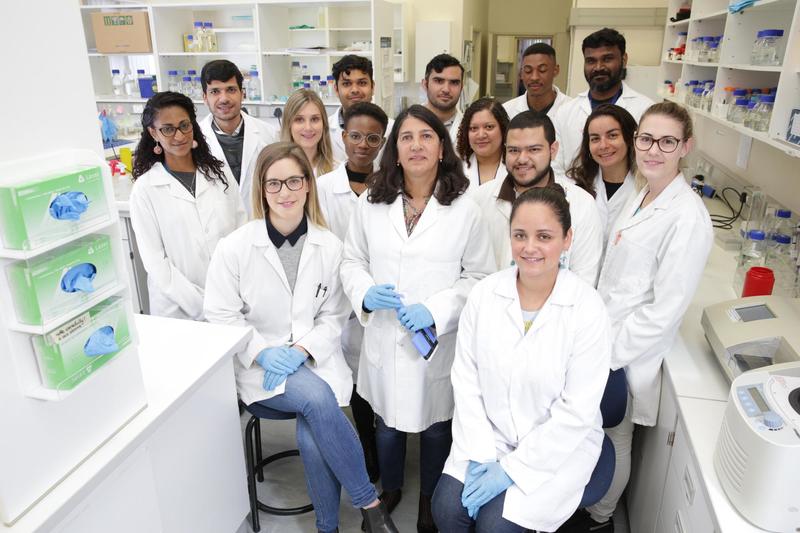Using palladium to fight cancer
05 October 2018 | Story Nadia Krige. Photo Michael Hammond. Read time 9 min.
As head of the Division of Cell Biology at UCT, Dr Sharon Prince has committed her academic career to cancer research. Her work focuses on finding novel therapeutic interventions and developing more targeted approaches to cancer treatment.
Apart from the stimulating research environment her laboratory has offered several postgraduate students and postdoctoral fellows, Prince’s expertise is also widely sought-after outside of UCT. She has had a long-standing relationship with the Cancer Association of South Africa (CANSA) and regularly presents her work at conferences and symposiums.
Understanding key drivers
Although Prince’s laboratory pursues several different arms of research, one of their major focuses right now is trying to understand what molecules drive a normal cell to become a cancer cell.
Dr Sharon Prince has committed her academic career to cancer research. Her work focuses on finding novel therapeutic interventions and developing more targeted approaches to cancer treatment.
“The idea here is, if we understand the key drivers of the cancer process, we can then use them as biomarkers for early detection, which is a huge problem in cancer,” Prince explains.
Apart from this, the identification of key drivers could offer researchers the opportunity to use them as ‘targets’ in the development of new treatments.
“Essentially, what we’re trying to do is target only the molecule that has been identified as a key component in the development of cancer, so that the normal cells remain unaffected.”
Targeted approach to cancer therapy
The idea behind this is to address one of the major drawbacks of most current cancer treatments, namely, the brutal side-effects many patients suffer while in therapy.
Widely available treatments, such as chemotherapy and radiation, tend to take a sledgehammer approach to killing cancer cells. While these treatments have a proven track record of efficacy, the big problem is that they also have a negative impact on normal cells in the body. This may manifest as hair loss and severe nausea in stronger patients, but it could end up being fatal for those with weakened immune systems.
“In fact, often patients would succumb to the treatment in the end, rather than the cancer,” explains Prince.
Widely available treatments, such as chemotherapy and radiation, tend to take a sledgehammer approach to killing cancer cells.
To this end, Prince is collaborating with the UCT Biopharming Research Unit to explore alternative, novel genetic therapy candidates with the use of pseudovirion technology in an attempt to downregulate expression of the TBX2/3 gene. Funding for this project was raised through the Technology Innovation Agency Seed Fund Programme with the assistance of Research Contracts and Innovation (RC&I).
The development of a promising palladium-based drug
Research suggests that one of the big reasons for the negative side effects of most anti-cancer drugs could be the use of the metal platinum as the core element in most of them. There is, however, evidence that the side-effects could be minimised by replacing it with a close metal relative, palladium.
Prince and her lab have teamed up with Professor Selwyn Mapolie from Stellenbosch University to investigate a range of palladium complexes for their anticancer activity.
Research suggests that one of the big reasons for the negative side effects of most anti-cancer drugs could be the use of the metal platinum as the core element in most of them.
After extensive in vitro, as well as in vivo tests, they discovered a palladium-based drug called AJ-5, which showed high anticancer activity with very little effect on normal cells. Importantly, AJ-5 was able to clear tumours in mice with negligible side effects. Its effectiveness also manifested at a 50 times lower concentration than the commonly-used platinum-based anticancer drug, cisplatin.
Eradicating cancer stem cells
In addition to these two exciting findings, AJ-5 also seems to be effective in targeting the small population of cancer stem- or precursor cells.
This is significant, as these precursor cells are notoriously difficult to eradicate, as they don’t look like the cancer cells they sprout. Because of this, drugs don’t target them and they remain latent in the patient’s body and often give rise to new tumours. This has commonly come to be known as a cancer relapse.
“Unlike a lot of current therapies that kill the tumours successfully, but leave the residual cells unaffected, AJ-5 seemed to be successful in killing off the entire population of cells completely,” says Prince.
After extensive in vitro, as well as in vivo tests, they discovered a palladium-based drug called AJ-5, which showed high anticancer activity with very little effect on normal cells.
There was only one major challenge with AJ-5, and that is the fact that it is not very soluble. This is a problem with a lot of drugs and ultimately becomes a restriction for taking their development further to clinical trials.
Prince’s laboratory wasted no time in looking for a solution and have tweaked the structure slightly to make it more soluble. This work is supported by the UCT Pre-Seed Concept Fund, as administered by RC&I, with the intention of demonstrating therapeutic proof of concept in a chick-embryo model.
The result has been a derivative drug called BTC2. Initial in vitro tests have shown that it promises to be equally, if not more, effective in removing cancer stem cells at an even lower concentration with negligible side effects on normal cells.
It is currently being prepared for in vivo testing.
RC&I is assisting with the intellectual property (IP) protection and a Patent Cooperation Treaty (PCT) application has already been filed as a precursor to patent applications in other countries and regions, which will be selected in due course. The IP is co-owned by Stellenbosch University.
Read more about UCT Research Contracts & Innovation…
 This work is licensed under a Creative Commons Attribution-NoDerivatives 4.0 International License.
This work is licensed under a Creative Commons Attribution-NoDerivatives 4.0 International License.
Please view the republishing articles page for more information.










